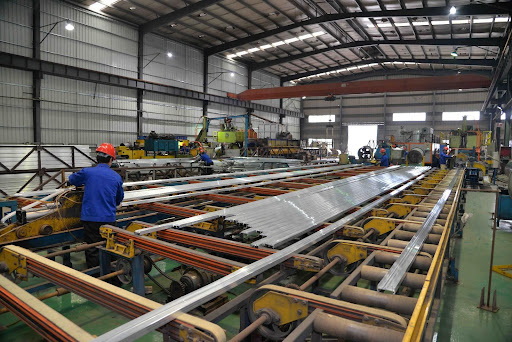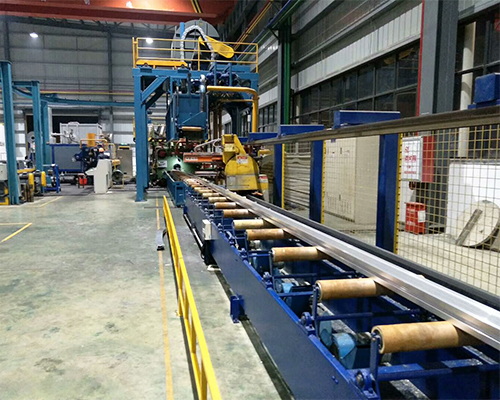English


Views: 222 Author: Tomorrow Publish Time: 2025-07-10 Origin: Site











Content Menu
● Overview of Aluminum Profile Manufacturing
● 3. Extrusion Molding (Core Process)
● 5. Cutting and Straightening
● 8. Precision Deep Processing
● 9. Quality Inspection and Packaging
● FAQ
>> 1. What alloys are commonly used in aluminum profile manufacturing?
>> 2. How does the extrusion process shape aluminum profiles?
>> 3. Why is aging treatment important for aluminum profiles?
>> 4. What surface treatments are available for aluminum profiles?
>> 5. How is quality ensured in aluminum profile manufacturing?
Aluminum profile manufacturing is a sophisticated and highly technical process that transforms raw aluminum materials into precise, high-performance profiles used across various industries. These profiles serve critical roles in construction, automotive, aerospace, electronics, and many other sectors due to aluminum's lightweight, strength, corrosion resistance, and excellent machinability. Understanding the key processes involved in aluminum profile manufacturing is essential for appreciating how these versatile components are produced with precision and quality.

Aluminum profile manufacturing primarily involves the extrusion process, where aluminum alloys are shaped by forcing heated billets through a die to form continuous profiles with specific cross-sectional designs. This process is complemented by several preparatory, finishing, and quality control steps that ensure the final product meets stringent mechanical and aesthetic standards.
The first step in aluminum profile manufacturing is selecting and preparing the raw materials. This involves:
- Aluminum Alloy Selection: Choosing the appropriate aluminum alloy, such as 6063, 6061, 6082, or 7075, based on the required strength, corrosion resistance, and application.
- Alloying: Adding elements like magnesium, silicon, zinc, and copper in precise proportions to achieve desired mechanical properties and stability.
- Casting Rod Production: Melting the aluminum and alloying elements at temperatures around 700°C, followed by refining and degassing to remove impurities and bubbles. The molten aluminum is then cast into cylindrical rods called billets, which serve as the starting material for extrusion.
The quality of the raw material directly influences the final properties of the aluminum profile. Impurities or inconsistencies in the alloy can lead to defects or reduced performance, making this initial stage critical.
Before extrusion, the aluminum billets are heated to approximately 400°C to 500°C. Heating softens the metal, enhancing its plasticity and making it easier to push through the extrusion die without cracking or deforming. Proper temperature control at this stage is critical to ensure smooth extrusion and optimal material properties.
The heating process must be carefully monitored to avoid overheating, which can cause oxidation or grain growth that negatively impacts the profile's strength and surface finish. Conversely, insufficient heating can lead to extrusion defects such as cracking or incomplete filling of the die.
The extrusion process is the heart of aluminum profile manufacturing and involves several key steps:
- Die Design and Preparation: Custom dies are designed and fabricated based on the desired profile shape and dimensions. The die must withstand high pressure and heat while maintaining dimensional accuracy. Die design is a highly specialized task, often involving computer-aided design (CAD) and simulation software to optimize metal flow and reduce defects.
- Extrusion: The heated billet is placed into a container and pushed through the die using a hydraulic press. The aluminum is forced to flow through the die opening, taking the shape of the profile.
- Emergence of Profile: The extruded aluminum emerges from the die as a continuous length of the shaped profile.
During extrusion, the metal experiences intense pressure and deformation, which refines its grain structure and improves mechanical properties. The extrusion speed, pressure, and temperature are carefully controlled to produce profiles with consistent dimensions and surface quality.
Immediately after extrusion, the aluminum profile is cooled rapidly to retain its shape and mechanical properties. Cooling methods include:
- Water Quenching: Passing the profile through a water bath.
- Air Cooling: Using fans or air jets to cool the profile uniformly.
This rapid cooling process, known as quenching, prevents unwanted microstructural changes and maintains the profile's integrity. The choice between water and air cooling depends on the alloy type and desired mechanical properties. For example, some alloys benefit from slower cooling to avoid internal stresses.
Once cooled, the continuous extrusion is cut into manageable lengths, typically between 8 and 21 feet, using precision saws. After cutting, profiles may exhibit slight twisting or bending due to residual stresses from extrusion.
To correct this:
- Stretching: Profiles are mechanically stretched using a stretcher machine that grips both ends and pulls the profile straight to meet dimensional tolerances. This process also helps to relieve internal stresses and improve dimensional stability.
- Straightening: Additional straightening processes may be applied to ensure flatness and alignment.
Proper straightening is essential for profiles used in structural applications, where precise dimensions and flatness are critical for assembly and performance.

To enhance strength and stability, aluminum profiles often undergo an aging process:
- Artificial Aging: The profiles are heated in ovens to specific temperatures for controlled times to precipitate alloying elements, improving mechanical properties.
- Common temper conditions include T5 and T6, which denote different aging treatments to achieve desired hardness and strength.
Aging treatments optimize the balance between strength and ductility, allowing aluminum profiles to perform reliably under mechanical loads. The aging process also stabilizes the microstructure, reducing the risk of deformation during subsequent machining or service.
Surface finishing is crucial for corrosion resistance, aesthetics, and wear resistance. Depending on the application, various treatments are applied:
- Anodizing: Electrochemical process that thickens the natural oxide layer, improving corrosion resistance and allowing for color finishes.
- Powder Coating and Painting: Adds protective and decorative layers.
- Sandblasting and Brushing: Creates specific textures or matte finishes.
- Hard Oxidation: Enhances surface hardness for wear resistance.
Surface treatments not only enhance the appearance but also extend the service life of aluminum profiles, especially in outdoor or harsh environments. The choice of treatment depends on the end-use requirements and environmental exposure.
Many aluminum profiles require additional machining and fabrication to meet specific customer requirements:
- CNC Machining: Cutting, drilling, tapping, grooving, and engraving to create features or prepare profiles for assembly.
- Assembly and Welding: Joining multiple profiles or components to form complex structures.
These secondary processes add value by enabling custom designs and ready-to-assemble components. Precision machining ensures tight tolerances and functional features that are essential for high-performance applications.
Throughout the aluminum profile manufacturing process, rigorous quality control is maintained:
- Dimensional Checks: Ensuring profiles meet design specifications.
- Surface Quality Inspection: Checking for defects, scratches, or inconsistencies.
- Mechanical Testing: Verifying hardness, tensile strength, and alloy composition.
Finished profiles are carefully packaged using protective films, bubble wrap, cartons, or wooden crates to prevent damage during transportation.
Quality control is a continuous process, with inspections performed at multiple stages to catch defects early and ensure that the final product meets customer expectations and industry standards.
Aluminum profile manufacturing is a complex, multi-step process that transforms raw aluminum alloys into precise, high-quality profiles used in countless applications. From raw material preparation and billet heating to extrusion, cooling, aging, surface treatment, and final inspection, each step is critical to ensuring the performance and durability of the finished product. Advances in extrusion technology and surface finishing continue to expand the possibilities for aluminum profiles, making them indispensable in modern manufacturing and construction.
By understanding these key processes, manufacturers can optimize production efficiency, improve product quality, and meet the evolving demands of industries relying on aluminum profiles.

Common alloys include 6063, 6061, 6082, and 7075, chosen based on strength, corrosion resistance, and application requirements.
Heated aluminum billets are forced through a custom die under high pressure, taking the shape of the die's cross-section to form continuous profiles.
Aging improves mechanical strength and stability by precipitating alloying elements within the aluminum matrix, enhancing hardness and durability.
Options include anodizing, powder coating, sandblasting, brushing, and hard oxidation, each providing corrosion resistance and aesthetic benefits.
Quality control involves dimensional checks, surface inspections, mechanical testing, and protective packaging to maintain product integrity throughout production and shipping.
Stainless Steel Grades 201 Vs 304: Cost Vs Performance Breakdown
316L Vs 316 Stainless Steel Grades: Which Is Better for Corrosion Resistance?
Comparing Austenitic Vs Martensitic Stainless Steel Grades: What You Need To Know?
Stainless Steel 430 Vs 304: Key Differences Explained for Manufacturers
304 Vs 316 Stainless Steel Grades: Which One Suits Your Project Best?
Stainless Steel Pipes Vs Galvanized Pipes: Durability And Cost Analysis
Comparing Stainless Steel Pipes And PVC Pipes: What You Need To Know?
Stainless Steel Pipes Vs Copper Pipes: Pros And Cons for Industrial Use
Seamless Stainless Steel Pipes Vs Welded Pipes: Key Differences Explained
Stainless Steel Pipes Vs Carbon Steel Pipes: Which One Suits Your Project?
